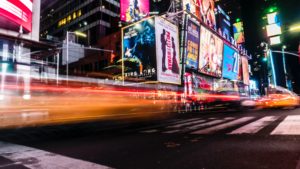
People moved to New York to enjoy the diversity of people, top-tier restaurants, museums, opera, clubs, bars, concerts, Broadway shows, a wide array of attractions, plentiful job opportunities and a high-energy, fast-paced environment. It was reported that in 2018, 65 million tourists flocked to New York City. They’d rent a hotel room and visit all of the iconic places, such as the Statue of Liberty, Empire State Building, Wall Street, Times Square and enjoy a Broadway play, music concert, shopping at upscale stores and dining out choosing from the extensive array of cuisines available.
The situation has changed dramatically. Manhattan has passed some of the strictest lockdown restrictions in the nation. All nonessential businesses were ordered to shut down. The once-overcrowded hustle-and-bustle streets looked like ghost towns. Slowly the bans were somewhat softened, but a recent second wave of the outbreak looks like there will be lockdowns once again.
Many people found themselves stuck in small, cramped apartments, as they were ordered to stay at home. The restaurants, clubs, gyms, hair salons, museums, concerts and sporting events abruptly closed down. There are reports of increases in lawlessness and crime. There were 344 murders in New York from January through September. The presence of homeless people became more widespread on the streets of New York.
Residents started questioning why they are paying so much money for rent when they can’t avail themselves to all of the offerings of Manhattan and are afraid of going outside. As job losses became more prevalent, city dwellers had to wrestle with paying a large amount of their salaries in housing costs and taxes, while either not having a job or holding onto their positions for dear life.
Prominent companies, including Google, Twitter and Facebook, offered their employees the option of working from home for the foreseeable future. A large number of other CEOs followed suit and offered this opportunity as well. The work-from-home movement untethered people who’ve been confined to a place that only offers a reasonable commute to work. As employees are able to work remotely, they can now live wherever they’d like and don’t have to remain in New York.
Roughly 300,000 residents have fled New York within the last eight months, according to the U.S. Postal Service. This number is likely higher, as the data doesn’t include all members of the household. A large number of the people who are leaving are wealthy. They have the financial means to purchase large homes in the nearby suburbs of New Jersey and Connecticut, the Hamptons on Long Island. With the ability to work remotely, people have migrated to lower-cost, warm-weather states with low taxes.
In addition to the exodus out of New York, tourism has plummeted—due to the pandemic. Tourism is one the largest revenue generators for New York. It brings in an estimated $72 billion, but this year is different. There have always been talks of the demise of New York. Despite the negativity, the City continues to find a way to revitalize itself. It won’t happen quickly, though. The New York Times reported that it may take at least four years to see a turnaround.
The tourist trade is a big moneymaker for New York hotels, restaurants, bars, nightclubs, taxi drivers and a host of other businesses and people who depend on the visitors. As Broadway shows close, Macy’s Thanksgiving parade, the Rockefeller Center Christmas tree lighting and New Year’s Eve ball drop canceled, a downward ripple effect occurs. Businesses that depend upon this trade may close their doors and lay off workers. Many of these people in the service industry won’t have many other options. The absence of tourists, residents leaving and a shutdown has hurt a large number of businesses, especially restaurants and hotels.
A sobering 1.3 million New Yorkers are collecting unemployment checks and the unemployment rate is over 14%. City officials and citizens are hoping for the rollout of a vaccine. Once the outbreak gets under control, the tourists will consider returning, so will the families that left. Until then, the outlook is bleak, but New York—as it always has—will rebound and restore to its former glory. It may take some time, but restaurants will reopen and people will go back to work.
Source: Forbes



Fascinating information! I cant believe Ive finally found the information Ive been searching for for so long. Thank you!
Hi, just wanted to tell you, I loved this blog post. Fayre Reece Demaria
You have made some decent points there. I checked on the internet for more info about the issue and found most individuals will go along with your views on this site. Addy Payton Russi
Hello, I enjoy reading all of your article. I wanted to write a little comment to support you.| Ruthann Lanie Corby
excellent issues altogether, you simply won a new reader.
We stumbled over here different website and
thought I should check things out. I like what I see so now i am following you.
Look forward to checking out your web page for a second time.
Hi, after reading this awesome piece of writing i am as well cheerful
to share my familiarity here with friends.
I follow you, you produce good content, congratulations!